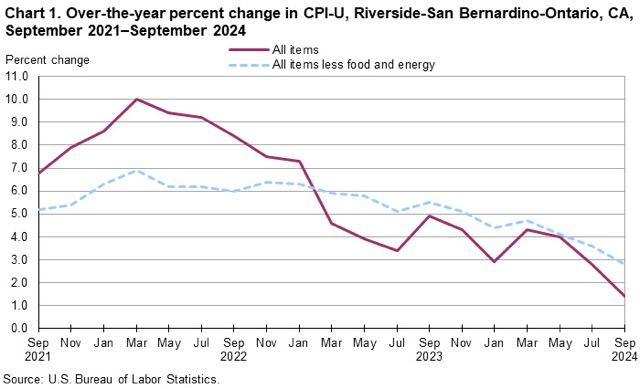Inland Empire Regional Inflation
RIVERSIDE (CNS) – Inflation throughout the Riverside metropolitan area was unchanged over the previous two months as rising price levels in some sectors of the regional economy were offset by drops elsewhere, according to data released Thursday by the U.S. Bureau of Labor Statistics.
The agency’s bimonthly report, which covers northwestern Riverside County, as well as the cities of Ontario and San Bernardino, indicated that the Inland Empire’s Consumer Price Index was flat compared to the summer season, when the CPI measured a modest uptick.
BLS officials said the energy sector accounted for the sharpest decline, registering a 1.9% drop in the months of August and September thanks to lower costs at the gas pump. Property rents, reflected in the index’s “shelter costs,” also fell, by about a half-percentage point, while prices on recreational activity, such as admission to entertainment venues, were down 2.7% over the two-month period, according to data.
However, trending higher were grocery prices, which climbed 1.2%, along with healthcare expenses and apparel costs, which rose 1.6% and 5.2%, respectively, according to federal officials.
Longer term, the regional CPI was 1.4% higher over the previous 12 months, with healthcare increasing pocketbook pressure the most at 7.7%, followed by rents at 3.6% and grocery prices at 3.1%, figures showed.
Energy costs were down 14.4% over the yearlong period, with prices on miscellaneous “goods and services” down 4.9% and household furnishings expenses registering a 3.3% slide on the year-over-year CPI.
The report showed inflation was up .2% nationwide last month, and 3.3% from September 2023 to September 2024.
The current rate of inflation reflects the elevated price trajectory impacting most sectors of the economy.
Accelerating consumer price hikes have been blamed by the Biden administration on the war in Ukraine and consequent energy supply disruptions, but critics have pointed to the administration’s restrictive domestic energy policies, as well as excessive spending, including the flood of dollars contained in relief packages, as root causes.
The national debt is $35.3 trillion, after passing $33 trillion a year ago, according to the U.S. Treasury Department. Estimated annualized interest rate payments on the country’s debt passed the $1 trillion mark in November 2023, according to Bloomberg News. That same month, Moody’s Investors Service lowered its outlook on the U.S.’s credit rating from “stable” to “negative.”
The Federal Reserve’s Open Market Committee gradually increased its benchmark, or target, lending rate in the spring of 2022 to soak up excess liquidity, though the FOMC suspended hikes last fall, and during its meeting last month, the committee announced a half-percentage point reduction, bringing the rate down to roughly 5% on the belief that inflation had been tamed.
For More Economy News Visit www.zapinin.com/economy.


